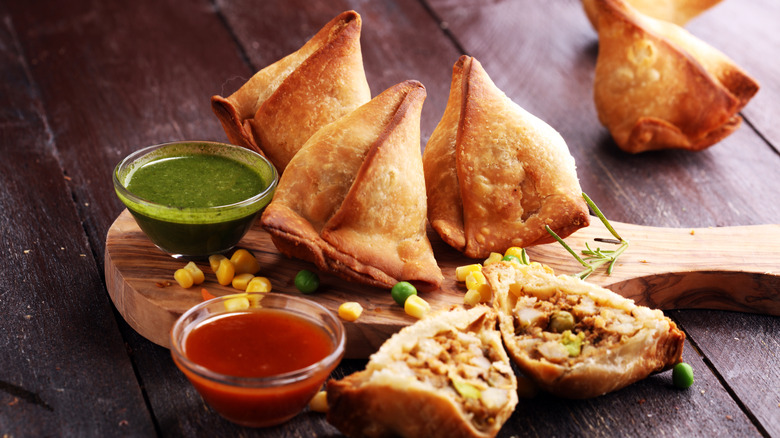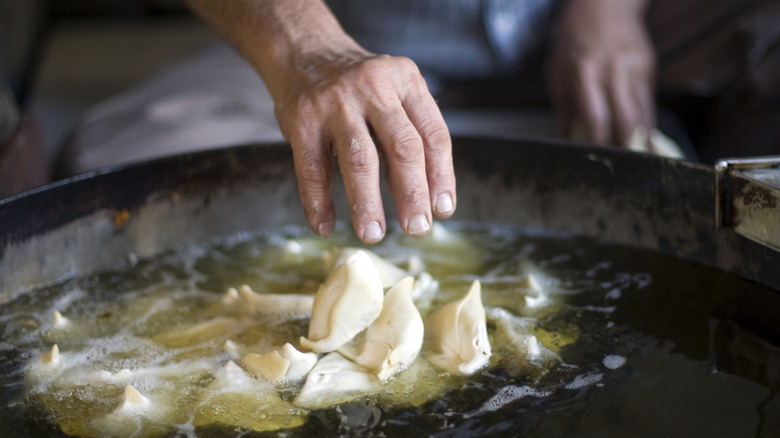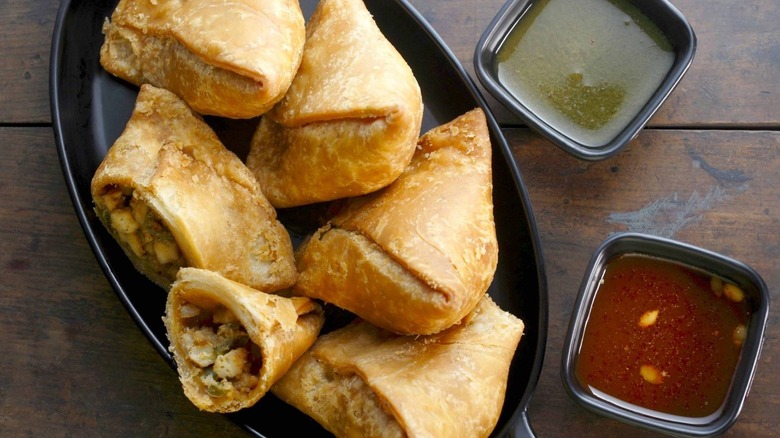What Kind Of Pastry Dough Do You Need For Classic Samosas?
Anyone familiar with South Asian cuisine will no doubt know about samosas. These triangular pastries can be made with a variety of fillings, like aloo (potato) or keema (spiced lamb), but the pastry itself is all-important. Deep-fried until golden and crispy, freshly cooked samosas should have a light crunch, with deliciously flaky pastry that crumbles with each bite, releasing a punch of flavor from the spicy interior. No wonder they're such a popular snack — one of the most widely enjoyed across South Asia, where they're often found on sale as street food. Additionally, like with many bite-sized foods, a plate of samosas is essential during Hindu festivals like Diwali.
The secret to these delectable treats lies in the dough, which is classically made with distinctly South Asian ingredients to give a rich, wholesome flavor. Samosas are best freshly cooked, and those of us elsewhere in the world can make them at home quite easily. When making your own, though, you may be tempted to improvise for simplicity. Samosas can be effortlessly made from folded Chinese spring roll pastry, for instance, and some recipes suggest using Greek-style phyllo pastry. Both of these options will give you light and crispy samosas, but for a plate of truly traditional snacks, there's no easy shortcut. The best choice by far is to take the time to make the pastry dough yourself. It may require a little effort, particularly if you aren't familiar with pastry, but the mouthwatering results will be ample reward.
Samosa dough is simple yet complex
If you ever get the chance to enjoy samosas in India, you'll notice how the pastry they're made with is often different from their Westernized cousins, a little sturdier while also being tender and avoiding the slightly chewy texture of supermarket samosas. The exact components and dough-making process can vary, and may be as straightforward as flour, salt, oil, and cold water kneaded together. Some of the most captivating versions, though, like the traditional Punjabi samosas of northern India, are made with ghee.
Ghee, among the most important ingredients in South Asian cooking, is a type of butter clarified in a distinctive process that imparts it with a rich, slightly nutty flavor and characteristic aroma. It's typically used together with maida, a finely ground Indian flour (although all-purpose is fine in a pinch), plus salt. Traditionally, fragrant, herbal ajwain (carom) seeds are also added to make the finished samosas more flavorsome. The dough is kneaded (by hand) similarly to shortcrust pastry, massaging ghee into the flour until it has a breadcrumb-like consistency. When it's ready to be turned into tasty samosas, a properly made dough will be firm and free from any stickiness.
While many samosas — including those from Tamil Nadu in India's south — are triangular, the Punjabi samosas eaten in the north are typically pyramid-like in shape. The dough is usually rolled out and cut into semicircles before being shaped into cones ready for filling.
Tips for excellent samosas
Whether you're hosting a social gathering or going to a potluck, a plate of vegetable samosas is sure to be welcome on any party table. They're incredibly moreish, after all. If you're cooking to impress, though, you'll want to pay careful attention to getting the finished pastries just right, and there are a few simple tips and tricks that can help.
Indian cooks will certainly tell you that it's vital to include the right amount of fat into your dough, with one guideline being to use a roughly 1 to 5 ratio of fat to flour, to ensure an ideal texture. Taking care to evenly spread the fat throughout, during the "breadcrumb" stage, will ensure the finished pastry is nicely flaky and crumbly. Finally, you be careful care not to add too much water, as this can prevent the pastry from gaining that essential crispy finish. It's best to knead the water in little by little, and be careful not to add too much.
It's also important to make certain you fry your samosas properly. It's best to use a light, neutral-tasting oil like sunflower or safflower. For a good finish, the oil should be medium-hot, and you should take care not to overcrowd the pan. If you'd prefer a lighter option, though, samosas can also be cooked very effectively in an air fryer. The ghee in the pastry will give the same crispy finish while avoiding any excess oiliness.


